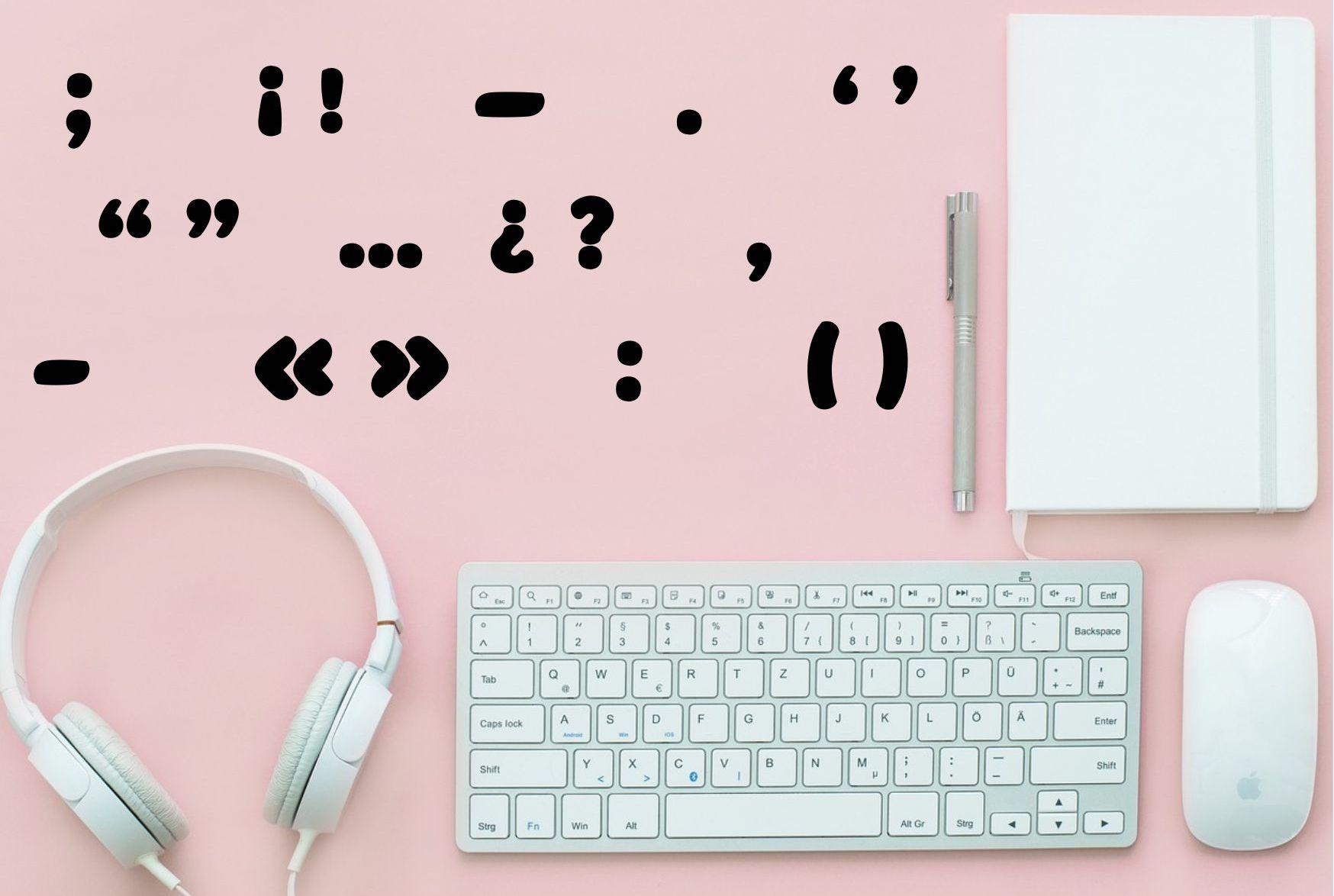Spanish Punctuation: An easy guide

Get our free email course, Shortcut to Conversational.
Have conversations faster, understand people when they speak fast, and other tested tips to learn faster.
More infoSpanish punctuation is essential, but far too often overlooked by language learners. At first glance, it may seem like English speakers and Spanish speakers use punctuation in the same ways. However, that’s actually not always the case.
At the end of this post, the principal differences between English and Spanish punctuation will be clear to you, and you will be able to use Spanish punctuation marks correctly, not only to understand texts better but also to write more precisely.
Spanish Punctuation Marks and their Symbols
Before we even get into any explanations, let’s just have a quick overview of the different punctuation marks in Spanish along with their names in both languages.
| Punctuation Mark | Spanish | English |
| ¿ ? | signos de interrogación | question marks |
| ¡ ! | signos de exclamación | exclamation points |
| . | punto | period |
| , | coma | comma |
| ; | punto y coma | semicolon |
| : | dos puntos | colon |
| … | puntos suspensivos | ellipsis |
| – | guión | hyphen |
| — | raya | em dash |
| ( ) | paréntesis | parentheses |
| « » | comillas españolas | angle quotes, guillemets |
| “ ” | comillas, comillas inglesas | quotation marks, double quotation marks |
| ‘ ’ | comillas simples | simple quotation marks, apostrophes |
Now that you recognize the most important Spanish punctuation marks, let’s discover their most common uses and differences between Spanish and English.
Question Marks – Signos de Interrogación
Just like in English, Spanish question marks indicate the existence of a question; the main difference is that, when writing in Spanish, you must include an upside-down question mark at the beginning of the interrogative phrase.
This significant difference in Spanish has an advantage. Seeing the Spanish upside-down question mark at the beginning of a phrase gives you a clue to identify that you’re reading an interrogative sentence, which means a different intonation is required.
Let’s look at some examples:
- How old are you? – ¿Cuántos años tienes?
- What did you have for breakfast? – ¿Qué desayunaste esta mañana?
Note that the opening question mark in Spanish must be placed where the question begins, even if it does not correspond to the beginning of the sentence. In that case, the word after the question mark starts in lowercase, and the upside-down question mark is preceded by a comma.
- You didn’t come to work yesterday; were you sick? – Ayer no viniste a trabajar, ¿estabas enfermo?
In English, when we stick a question onto the end of a sentence, changing the sentence from a phrase to a question, these are called “tag questions,” as in this next example:
- It’s still too early for dinner, don’t you think? – Aún es muy temprano para cenar, ¿no crees?
Exclamation Marks – Signos de Exclamación
Spanish exclamation marks help demonstrate that we’re exclaiming or interjecting.
They have something in common with Spanish question marks: you must include an opening exclamation mark at the beginning of the phrase and a closing exclamation mark at the end:
- You look gorgeous in that dress! – ¡Te ves preciosa con ese vestido!
- Run! The train is about to leave. – ¡Corre! El tren ya va a partir.
When the meaning of a sentence is interrogative and exclamatory at the same time, question marks and exclamation points can be combined. In these cases, you can open with the exclamation point and close with the question mark, or vice versa.
For example:
- Oh no, what are you doing!? – ¡Ay no, qué estás haciendo?
Period – Punto
In both English and Spanish, a period indicates a pause and marks the end of a statement in a sentence or text. In both languages, the word that follows the period is always written with a capital letter.
- The class is over. Please put your things away. – La clase ya terminó. Guarda tus cosas, por favor.
Types of periods in Spanish
Now, there is a peculiarity concerning the Spanish period: it can have three different names depending on its function.
These names are punto seguido – period and continued, punto y aparte – period and aside, and punto final – final period.
The punto seguido is used when you want to separate two consecutive sentences within the same paragraph.
The punto y aparte indicates the end of a paragraph and the beginning of a new one with a different idea.
And, last but not least, a punto final is used when you have finished writing. You can find it at the end of an email, letter, article, chapter, book, etc.
Periods for abbreviations and for time
The period is also present after abbreviations and sometimes for referring to the time.
- Mr. – Sr.
- The library closes at 5:30 p.m. – La biblioteca cierra a las 17.30 h.
If you want to go into more depth in either of these topics, we have dedicated posts on titles in Spanish, and on telling time in Spanish.
Periods and commas with numbers
Another important detail that can sometimes lead to confusion is the use of periods and commas for separating the thousands and as the decimal point: In most of the Spanish-speaking world, when writing numbers, we use commas where English speakers use decimal points and periods where English speakers would usually use commas!
- The business made exactly $1,143,600.90 last year. But after taxes, there was only $840,401.01 left. – El negocio ganó exactamente $1.143.600,90 el año pasado. Pero después de los impuestos, solamente quedó $840.401,01.
- We got 1,500 votes. – Obtuvimos 1.500 votos.
- That book cost $15.50. – Ese libro cuesta $15,50.
However, in Spain and in North America (namely in the US), you may still see numbers written with the same English punctuation.
Periods with other Spanish punctuation marks
As is the norm in English, a period goes after parentheses in Spanish.
- He lived in Paris for many years (from 1956 to 1980). – Vivió en Paris por muchos años (de 1956 a 1980).
Contrary to the norm in English, however, the period also goes after Spanish quotation marks:
- Antes de salir me dijo: «hoy ceno por fuera». – Before leaving, he told me, “I’m having dinner out today.”
Comma – Coma
Similar to English, the comma in Spanish appears when you need to list items, separate clauses, include tag questions, or add explanatory information within a sentence. However, some little aspects change.
For example, Spanish speakers don’t use the Oxford comma, which means that when listing things, we don’t place a comma between the second-to-last list item and the conjunction y or o.
- Tomorrow, I have to prepare breakfast, clean the house, do the shopping, and answer the mail. – Mañana tengo que preparar el desayuno, limpiar la casa, hacer mercado y responder al correo.
- How delicious is this hamburger, right? – Qué rica está esta hamburguesa, ¿verdad?
- Lucia, my best friend, is a renowned scientist. – Lucía, mi mejor amiga, es una reconocida científica.
- I like math, science, and philosophy. – Me gustan las matemáticas, la ciencia y la filosofía.
The placement of the comma within a quote is another element that differs between Spanish and English. In Spanish, the comma is placed after the last quotation mark or angle quotes, outside of the quote. In English, on the other hand, we put it before the last quotation mark, even if that punctuation mark isn’t part of the quote.
- “We have to take action to fight corruption,” said the president. – “Tenemos que tomar acción para combatir la corrupción”, dijo el presidente.
- “It’s time to go to sleep,” said the child’s mother. – «Ya es hora de ir a dormir», dijo la madre. – “Ya es hora de ir a dormir”, dijo la madre.
Colon – Dos puntos
The colon in Spanish is used for enumeration, explanation, or quotes, just like in English.
However, there is a specific use native speakers give to this Spanish punctuation mark: in emails or letters, greetings are written using colons, whereas in English you usually use a comma unless you’re being very formal.
For example:
- Dear Patricia, – Querida Patricia:
Hyphen and Em-dash – Guión y Raya
In Spanish, the em-dash is used to separate lines within a dialog or to add explanations.
For example:
- —Excuse me, what time is it? – —Disculpe, ¿qué hora es?
—It’s 6:30. – —Son las 6:30.
—Thanks – — Gracias
- Toby —my brother’s dog— is a golden retriever. – Toby —el perro de mi hermano— es un golden retriever.
Above, we used the em-dash to separate a parenthetical idea. We could also use parentheses for this function.
The hyphen, on the contrary, unites two words or lets the reader know that a word continues in the next line.
- Fact–fiction – Realidad–ficción
Note that in contexts where two English words may be joined with a hyphen to comprise a compound adjective, there is no such hyphen in Spanish:
- Jorge is a full–time employee. – Jorge es un empleado de tiempo completo.
Angle Quotes and Quotation Marks – Comillas Españolas and Comillas Inglesas
In general, quotes indicate expressions, dialogues, irony, titles of books, movies, etc. Native Spanish speakers tend to prefer angle quotes; however, quotation marks are also common nowadays.
As mentioned before, commas, periods, exclamation points, and question marks are placed after the last quotation mark in Spanish, regardless of whether we are using double quotation marks or angle quotes.
- On Monday, didn’t you say, “I promise I will bring pizza to the office on Friday?” – El lunes, ¿no dijiste: «prometo que el viernes traeré pizza a la oficina»?
- “You must be the change you wish to see in the world.” – «Sé el cambio que quieres ver en el mundo». – “Sé el cambio que quieres ver en el mundo”.
- My favorite movie is “The Lord of the Rings.” – Mi película favorita es «El Señor de los Anillos». – Mi película favorita es “El Señor de los Anillos”.
You may also find angle quotes, quotation marks, and even simple quotes together in dialog lines to facilitate comprehension.
- Daniela told me, “he didn’t come with me to get the book ‘One Hundred Years of Solitude’ because he was ‘too busy.’” – Daniela me dijo: «no me acompañó a buscar el libro “Cien años de soledad” porque estaba ‘muy ocupado’».
Conclusion: Spanish punctuation
Learning how to use punctuation marks in a new language may seem challenging, but the good news is that Spanish punctuation marks work pretty similarly to the ones in English. There are only a few crucial differences to be aware of.
Here we took you through the various nuances of Spanish punctuation that differ from English. We started with the two that stand out most to language learners: the upside question mark and exclamation mark. We then went over the details of the Spanish period, as well as the specifics of the comma and the colon. We saw how the dash and em-dash are both pretty close to their English counterparts. And we rounded out our post with our section on quotation marks in Spanish, which have both different forms and some different usage rules.
The best way to improve your grasp of punctuation in Spanish is to read plenty of texts in the language. With this detailed introduction to Spanish punctuation, you should be able to recognize the different details we covered here when you see them. And as you continue learning the language, you’re now prepared to use the right Spanish punctuation marks in your own writing!



